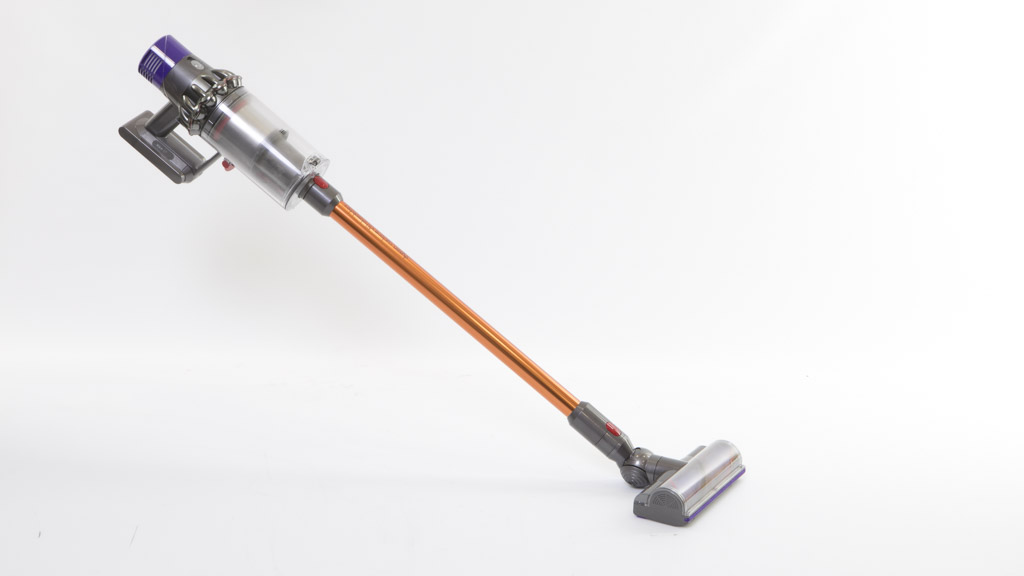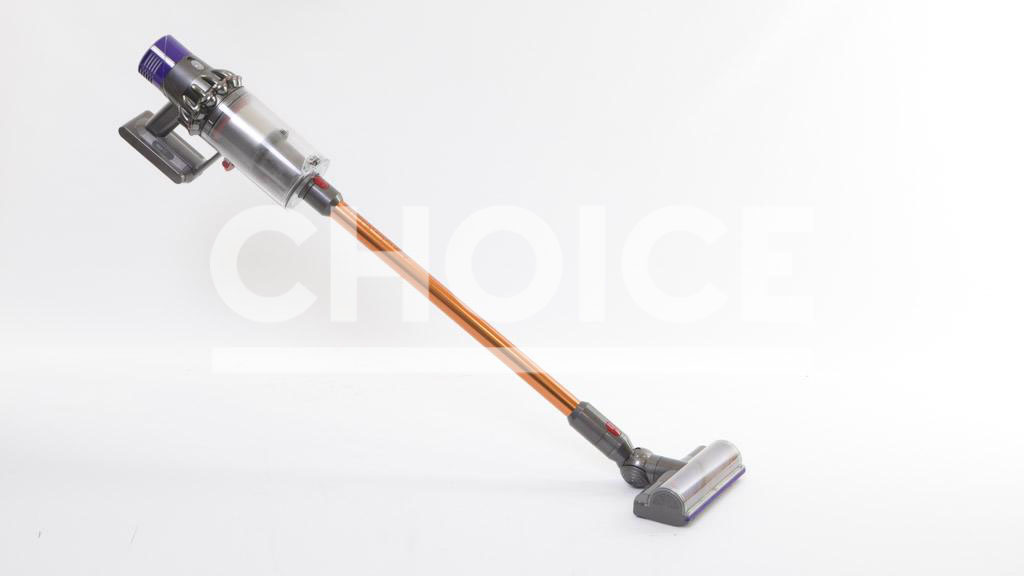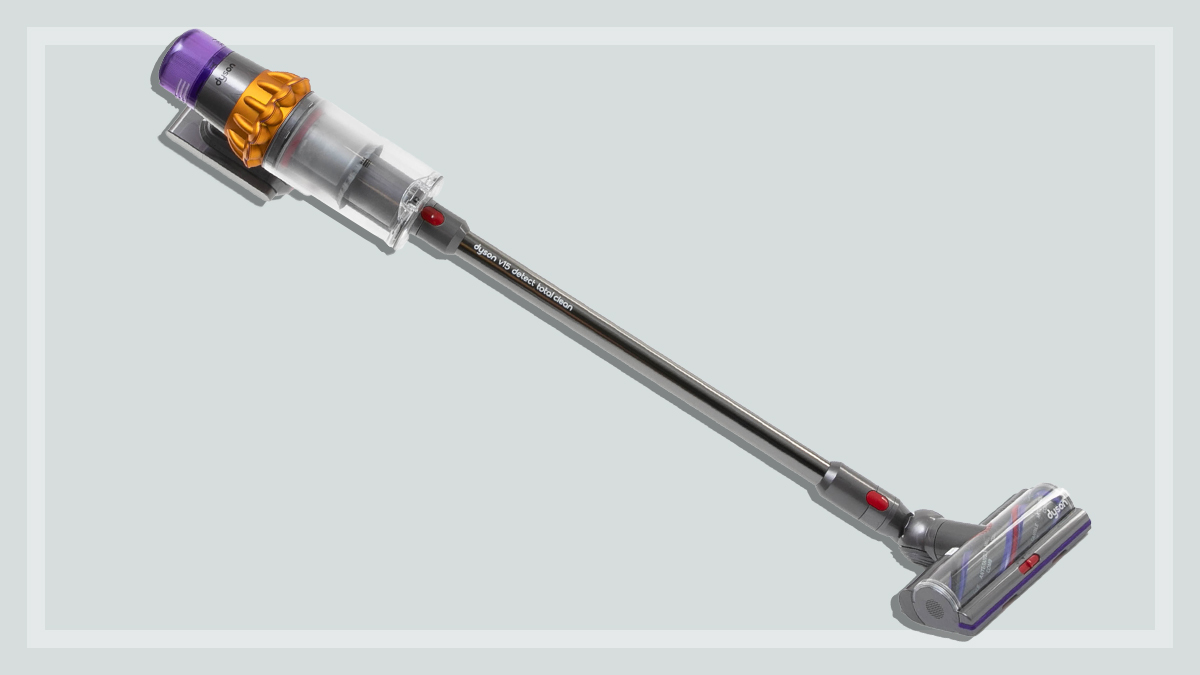Get our independent lab tests, expert reviews and honest advice.
Dyson Cyclone V10 review

CHOICE verdict
On maximum mode particularly, the Dyson Cyclone V10 Absolute+ delivers on its full-size suction power promise. It’s easy to use, but less compact than the previous V8. The usual stick vacuum problems about having to change the bin and worrying about when you’re going to run out of battery are still there, but Dyson’s gone some way to address this with the battery indicator and increased dust capacity.
Price: $999
Contact:
dyson.com.auOn this page:
- How is the Dyson V10 different to the V8?
- Dyson Cyclone V10 performance test results
- Is the Dyson V10 easy to use?
- Should you upgrade to a Dyson V10?
Stick vacuums, which are relatively lightweight and operate on rechargeable batteries, have surged in popularity. Already, 28% of CHOICE members surveyed own a stick vacuum, and 73% of them opt for a Dyson, which enjoys high satisfaction and reliability.
Many CHOICE community members (and staff) use their stick vacuums all around the house, on carpet and hard floors, and Dyson is looking to capitalise on this. The company has boldly stopped developing the mains-powered vacuums it became famous for in the 1990s. Ahead of the launch of the Dyson Cyclone V10 cord-free vacuum, founder James Dyson told reporters he sees the future as “being entirely in battery machines”.
Should the corded establishment be worried about the shake-up in this suction space? We tried out Dyson’s top-of-the-range V10 model, the $999 Absolute+, ahead of its global March 2018 release for a first look, putting it through its paces in our purpose-built vacuum labs to see how it really compares to traditional barrel or upright vacuums.
Related stick vacuum reviews
- Dyson V15s Detect Submarine
- Dyson V15 Detect
- Dyson Gen5detect Absolute
- Dyson V11 Outsize
- Dyson V11 Absolute
- Dyson V8 Absolute

How is the Dyson V10 different to the V8?
Battery life limitations aside, our tests in 2016/17 of the cordless Dyson V8 stick vacuums (Dyson’s fastest selling vacuums to date) show how the performance gap between corded and cordless vacs is decreasing, with impressive dirt pick-up from carpet that is comparable to many full-size, corded vacuums.
Compared with the V8, the V10 claims to have:
- 20% more suction power: Visually, the V10 differs from its predecessors because the main unit’s cyclone motor and bin assembly is located on the same horizontal plane as the wand, whereas earlier models have the cyclone and bin assembly at a right angle to the wand. Dyson claims the new design improves the suction power, as dirt and dust is collected in an “in-line” format. The motor also spins 2000 times a second; its fastest yet.
- 40% bigger bin capacity: Our measured dust capacity of the V8 was only 0.3L and the V10 is 0.5L. It’s certainly an improvement, but nowhere near the capacities of, say, the 2–3.5L you see on a bagged Miele. Overall the unit weighs around 100g more than the V8, at 2.6kg, which isn’t much, but the unit is bulkier due to its larger size.
- up to 60 minutes of suction: In reality, this depends on the power level you’re using (low, medium or max), and whether you’re using a motorised tool, as that will drain the battery faster. In practice, our tests show that in max mode with the brush bar employed, the battery on the V10 only lasts a mere nine minutes – the same amount we measured on the V8. We tested the battery on medium settings with the motorised brush bar, and it lasted almost 26 minutes. (The all-important battery indicator will help prevent any “range anxiety” about the battery suddenly conking out unexpectedly. As Dyson is also developing an electric car, we hope that it will last much longer than nine minutes – that won’t even get you a few hundred metres through morning gridlock.)
- the ability to tell the weather: Yes, you read that right. Apparently the V10 knows its altitude, barometric pressure and temperature, and adjusts its performance accordingly whether you’re in the mountains or by the sea (our carpet tests are always conducted in the same temperature and humidity controlled room, so we can’t tell you how it will perform on Mount Everest). It also knows “where” you are using it in the room (say up on a ceiling or on the floor).
Dyson Cyclone V10 performance test results
We always test our stick vacuums on their highest speed setting to give them the best chance. We tried the V10 on max, but checked out how it fares in medium mode too.
Our test is conducted on hard floors with cornflakes, potting mix and flour, and we test them over two runs on carpet with a set amount of sand, and also with embedded pet hair, using the appropriate brush heads. We also conduct a “quick clean” test which involves a mere four passes across the carpet rather than 10, as we don’t think people go over their carpet 10 times unless there’s a particularly difficult spot.
The results of this test in max mode are impressive. But how does it compare with mains-powered vacuums?
When the limitation of battery life is out of the equation, the V10 generally performs better or as well on carpet than the mains-powered range of Dyson vacuums, and on that basis we think it lives up to its claim of having full-size suction power (for nine minutes, at least). It performs better than many vacuums we’ve tested, but our top-rated traditional vacuums are still better if you don’t want to be constantly emptying the V10’s relatively tiny dirt receptacle or worrying about battery life.
Dirt pick-up from carpet is very good, and even “quick clean” dirt removal is good. It’s also excellent in the more compact handheld mode if you’re cleaning pebbles from your car.
What about the longer lasting medium mode? Predictably results aren’t as impressive as they are in max mode, but they’re still good and would suit those ‘in between’ cleans.

Is the Dyson V10 easy to use?
- Trigger control: Those familiar with Dyson stick vacuums will know they’ll only operate when the trigger control is squeezed, and it doesn’t have an on/off switch. This means you don’t have to worry about the battery wasting away when the vacuum is idle, and that’s especially important when you’re using it on its most powerful setting. The same trigger design is employed on the V10.
- Tool selection: There’s a good range of easy to use tools. Apart from the motorised power head, power soft head and small power head, the $999 Absolute+ we looked at comes with a number of cleaning accessories including an extendable crevice tool, flexible crevice tool, small dusting brush with upholstery tool and more. However, there’s only storage on the battery charger wall support for two of them. The Animal, which costs $100 less, doesn’t come with a soft head or some of the other accessories.
- Emptying the bin: There’s a rubber ‘skirt’ pushing the dirt out when you empty it, which happens in one action, and it was easy to do. The filter is also very easy to remove for cleaning and there is only one to worry about, wrapped around the motor.
- Ease of controls and operation: We found the controls very good; with variable power selections located on the main body and very easy to operate. The unit’s easy to manoeuvre on floor and carpet, but note that it is bulkier than its predecessors. If you wanted to reach up high to clean a ceiling, those with weaker wrists might find it challenging to hold with one hand. Getting it out for smaller jobs might be more of a hassle than a more compact stick vacuum.
We didn’t rate these other features, but they include:
- Battery indicators: high, medium and low charge levels light up in blue, with a flashing blue light indicating an empty battery. It takes 3.5 hours to charge, compared with 5 hours for the V8.
- Blockage indicator: Prompts you to disassemble the unit to find and unblock any obstructions
- Filter alert: If your filter needs washing (which should be done every month), the vacuum lets you know.
- Lights diagnostics: Red flashing light tells you it’s a battery problem, a full red light means it’s a main body fault.

Should you upgrade to a Dyson V10?
While we think the V10 is well worth a look, and in max mode can rival many traditional vacuums, if you’ve already got a Dyson V8 (and a mains powered vac) and are happy with them, there’s no immediate need to rush out and upgrade as it costs $899–999.
While the V8 has a longer battery charge time and a smaller bin capacity, it’s still a great performer.
Those who own a pre-V8 model will probably enjoy the biggest difference, as there is a significant jump in power and battery life. We don’t know how long the V8 will be around, but the accessories on the V10 are reportedly backwards compatible with the V8, so you could theoretically have two in the house, maybe to swap over when the battery runs out on one of them.
Note: While we usually buy products in-store as a consumer would before testing, this time we used a review model for our first look ahead of its release. Since then, we’ve conducted a full comparative review of stick vacuums including the Dyson V10 and Dyson V8 plus other models from LG, Electrolux, Bosch and more.






